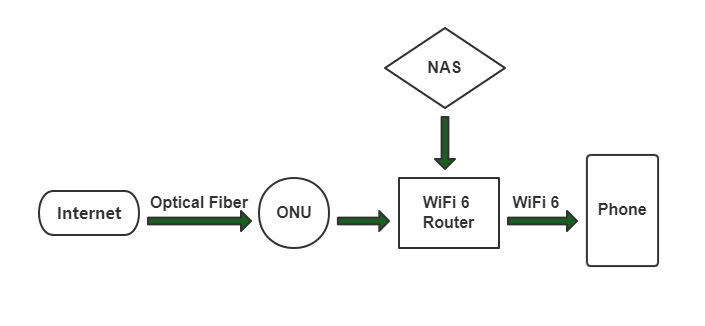WiFi 6 vs WiFi 5, Which is Better in Performace?
Called "the next generation of WiFi", WiFi 6 has attracted the public's attention when it first occurred. What does it make WiFi 6 so different? What's the difference between WiFi 5 and WiFi 6?
![]() Page Contents:
Page Contents:
2. Why is WiFi 6 superior to WiFi 5?
3. Application of WiFi 6
Part I. What are WiFi 6 and WiFi 5?
WiFi is a WLAN technology based on IEEE 802.11. Thus, 802.11n is named WiFi 4. WiFi 5 and WiFi 6 also represent IEEE 802.ac and IEEE 802.ax separately. WiFi 6 is developed based on WiFi 5 and has a better performance. Nowadays, more and more WiFi 6 devices are occurring on the market. WiFi 6 will become mainstream in the near future. But it's also a little bit difficult for some industries to upgrade their product to support WiFi 6 due to technical problems at present. Once the problem is solved, WiFi 6 will cover everywhere in our life. Obviously, WiFi 6 is better than WiFi 5. In this post, we will introduce the aspects in which WiFi 6 is superior to WiFi 5.
Part II. Why is WiFi 6 superior to WiFi 5?
1. Speed
Compared with WiFi 5, the largest transmission rate of WiFi 6 reaches 9.6Gbps, which is 3 times larger than the rate of WiFi 5. If we convert the 9.6Gbps into the download speed that we always use, it's 1228.8MB/s or 1.2GB/s.
Notes:
The speed here we mention is meant to the speed that you connect your device like your phone or computer to the router instead of the real Internet speed. The WiFi 6 can't improve your Internet speed greatly if the speed of your broadband is low. But WiFi 6 makes a difference in LAN transmission.

2. Frequency
As for the frequency, WiFi 5 only supports 5GHz, but WiFi 6 covers 2.4GHz and 5GHz. As we all know, the coverage of WiFi signals will be narrowed with the increase of frequency. Thus, 5GHz is faster than 2.4GHz but covers smaller areas. With the dual bands of WiFi 6, you can cover larger areas with 2.4GHz and acquire higher speed with 5GHz.
3. Efficiency and Delay
In comparison with WiFi 5, the biggest change of WiFi 6 is improving the efficiency and reducing the delay. For 802.11 a/b/g/n, they adopt OFDM as a major transmission solution. However, WiFi 6 improves it into OFDMA, which can serve multiple users at the same time.
What's more, the spatial data flow of WiFi 6 is improved from WiFi 5's 4 to 8, suggesting that WiFi 6 can maximumly support 8x8 MU-MIO, The average latency of WiFi 6 is 20ms, which is 10ms less than the WiFi 5's. Therefore, the efficiency is greatly improved and the latency is decreased. The Internet can maintain stability even more devices connected to the router.
4. Security
WiFi 6 adopts the WPA 3. In 2018, the WiFi organization issued the new generation of encryption protocol WPA 3, which is upgraded from the previous WPA 2. The security of WPA 3 is improved, which can prevent the brute force attack better.
5. Power consumption
WiFi 5 works in a mode that when the terminal device is transmitting data with the router, other devices are waiting for receiving data out of order. Differently, WiFi 6 introduce the new technology TWT. It means that other devices enter sleep mode when one device is working, which reduces power consumption and increases the battery life of the device.
Part III. Application of WiFi 6
1. Carry 4K/8K/VR and other large broadband videos
As we mentioned above, WiFi 6 supports dual bands of 2.4GHz and 5GHz. The 5GHz supports bandwidth of 160MHz and the highest access rate reaches to 9.6Gbps. Moreover, there is relatively less interference for 5GHz. All these features make WiFi 6 more suitable for transmitting videos with large broadband.
2. Carry low-latency services like online games
Online games have high requirements in broadband and time delay. Generally, the best access method for VR games is to use wireless networks. WiFi 6 can provide a special signal channel for games. So Wi-Fi 6's high efficiency and low latency exactly fit for games like VR games.
3. Smart home
There are more and more smart-home devices like intelligent door locks or cameras, which largely enhances our life convenience. Now many router developers are producing and promoting WiFi routers supporting WiFi 6. For instance, Huawei launched the family WiFi 6 router and V-SOL produced 5G CPE with WiFi 6.

Notes:
Your terminal devices like your mobile phone also need to support WiFi 6 then you can enjoy WiFi 6 services when you have the WiFi 6 router. At the moment, the chips of WiFi 6 routers develop better than that of terminal devices. Most phones supporting WiFi 6 only are 5G phones.
After the comparison, we've known that the performance of WiFi 6 is better than that of WiFi 5. WiFi 6 is entering our life, optimizing our Internet experience and bringing us more convenience.